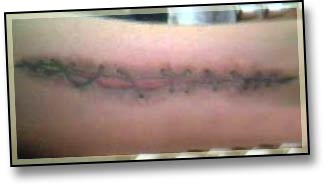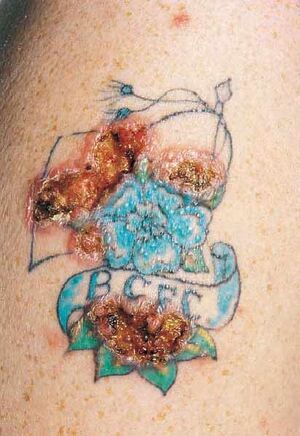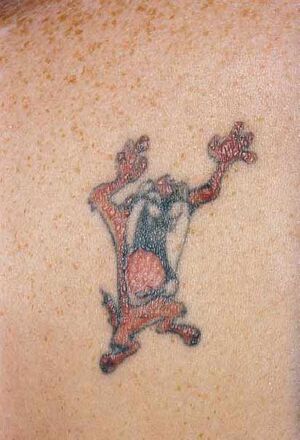Ink Allergy
[Tattoo inks](/index.php?title=Tattoo_Ink) are totally unregulated and generally [tattoo](/index.php?title=Tattoo) artists are not even aware of what specific ingredients make up the pigments — only a small amount of tattoo ink is ink allergy tested. These pigments range from metal oxides to synthetic organic dyes. Inks most commonly reacted to include reds and yellows. Some people have reacted with red, bumpy, sore, or itchy skin on and around the tattoo. Some people will have more severe reactions such as blistering, skin lesions, and persistent infections.
In the tattoo photo shown here, the surrounding "glow" on the tattoo is allergic reaction — this was not tattooed on. Below are two more serious reactions:
| Photos of red ink allergy, as presented by Nicholas White MRCS and Gulraiz Rauf FRCS in a letter to the British Journal of Plastic Surgery (doi:10.1054/bjps.2002.3838). | |
The photo on the left (blue flower) shows ulceration in the red ink areas at one month. The photo on the right (Tasmanian Devil) is on the same person, but at four years — it showed no reaction until they got the second tattoo, which caused the first to flare up as well. Treatment was with [silver sulphadiazine](/index.php?title=Silver_Sulphadiazine) dressings and it healed in two weeks. No red ink stayed in the tattoo on the left, but the ink stayed in the one on the right.
It should be noted that allergies can develop over time with exposure (which is why there are more rice allergies in Asia than North America; but those allergies don't start occurring until fifty or so), and that they may not show up until years later (when the allergy develops). A tattoo artist wrote us to recount,
- "I am a 29 year old male tattoo artist. I have over 70 tattoos on myself. Recently I became allergic to the pigment of yellow ink. The tattoos were on over a year before the reaction began. So just because a tattoo looks good at first watch out for future problems. The artist him or herself cannot prevent a reaction regardless of experience or sterile environment. This is a painful and aggravating thing to go through. So think before you ink!!!"
Ink that you've become allergic to can be removed by a doctor using a laser (or by excision), but most people just "put up with it" and use allergy creams and so on when they need to. Also, many people will just have these allergies during hot weather (environmental factors are definitely at play). This writer describes their experiences,
- "I've had a reaction to red ink: a swelling, itching and general puffiness of the inked area... and also a peeling and scabbing of the area. YUCK! I've found a topical anti-histamine is the trick to keep from ripping the skin off. The only regret I have about getting my tat is lack of knowledge of these allergies — If only I had done more thorough research!"
While you could get spot tests done in theory with tattoo ink, this is virtually unheard of and in my opinion not entirely viable, and there is no readily available way to know in advance whether you will have such a reaction. Thankfully they are quite rare.
See Also
- [Lymph Node Pigmentation](/index.php?title=Lymph_Node_Pigmentation)
- [Tattoo](/index.php?title=Tattoo)
- [Ink Rubbing](/index.php?title=Ink_Rubbing)


